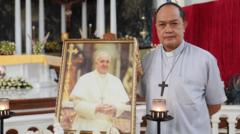After the initial vote concluded without a decision, the 133 cardinals sequestered in the Sistine Chapel are set to reconvene on Thursday morning to continue the voting process. As the conclave unfolds, discussions about the future direction of the Roman Catholic Church are at the forefront, with debates between progressive and conservative factions shaping the context of the election.
Voting Continues in Vatican Conclave as Black Smoke Signals No Pope Elected

Voting Continues in Vatican Conclave as Black Smoke Signals No Pope Elected
The Vatican conclave, tasked with selecting a new pope for the world's 1.4 billion Roman Catholics, revealed black smoke on its first voting night, indicating that an agreement was not reached among the cardinals.
Black smoke rose from the chimney of the Sistine Chapel on Wednesday night, signaling that the first ballot in the papal conclave did not achieve the required two-thirds majority among the 133 participating cardinals. The conclave, the first in more than a decade following the death of Pope Francis, has commenced during a pivotal time for the Roman Catholic Church, grappling with internal divisions, financial struggles, and the legacy of past sexual abuse scandals.
The cardinals will return to vote on Thursday morning, adhering to a tradition that blends secrecy and solemnity. During their confinement within the chapel, they will remain without access to phones or the internet, under strict oaths of confidentiality. Following their voting procedures, the burning of ballots signifies the outcome through colored smoke — black for no decision, white for the election of a pope.
This conclave is uniquely characterized by the arrival of many newly appointed cardinals, making for a potentially less predictable voting process. The cardinals’ identities and political alliances, influenced by Pope Francis’ tenure, could contribute to a more fragmented decision-making environment.
As the cardinals are expected to resume voting with round two scheduled for around 10:30 a.m. local time, discussions about their candidates have already begun to stir among observers. Notable potential successors include Cardinal Pietro Parolin, seen as the continuity candidate under Francis' reformist approach, and Cardinal Luis Antonio Tagle, who represents the growing base of Catholicism in Asia.
The conclave is being watched closely not only for who will emerge as the new pope but also for its reflections of broader church dynamics at work during a period of substantial transformation within the Vatican. Bringing the nuances of these dialogues to light, the eventual outcome may well turn into a referendum on the legacy of Pope Francis, testing the appetite for continued inclusivity or a return to conservative stances within the church’s leadership.
The cardinals will return to vote on Thursday morning, adhering to a tradition that blends secrecy and solemnity. During their confinement within the chapel, they will remain without access to phones or the internet, under strict oaths of confidentiality. Following their voting procedures, the burning of ballots signifies the outcome through colored smoke — black for no decision, white for the election of a pope.
This conclave is uniquely characterized by the arrival of many newly appointed cardinals, making for a potentially less predictable voting process. The cardinals’ identities and political alliances, influenced by Pope Francis’ tenure, could contribute to a more fragmented decision-making environment.
As the cardinals are expected to resume voting with round two scheduled for around 10:30 a.m. local time, discussions about their candidates have already begun to stir among observers. Notable potential successors include Cardinal Pietro Parolin, seen as the continuity candidate under Francis' reformist approach, and Cardinal Luis Antonio Tagle, who represents the growing base of Catholicism in Asia.
The conclave is being watched closely not only for who will emerge as the new pope but also for its reflections of broader church dynamics at work during a period of substantial transformation within the Vatican. Bringing the nuances of these dialogues to light, the eventual outcome may well turn into a referendum on the legacy of Pope Francis, testing the appetite for continued inclusivity or a return to conservative stances within the church’s leadership.





















